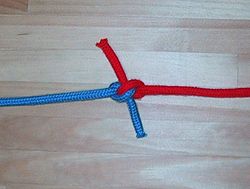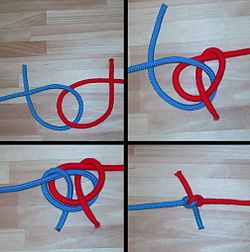m (W126jep moved page Adventist Youth Honors Answer Book/Knot/Hunter's bend to AY Honors/Knot/Hunter's bend without leaving a redirect: Part of translatable page "Adventist Youth Honors Answer Book/Knot/Hunter's bend") |
|||
| (20 intermediate revisions by 4 users not shown) | |||
| Line 1: | Line 1: | ||
| − | + | <noinclude><translate><!--T:3--> | |
| + | </noinclude> | ||
| − | + | <!--T:6--> | |
| + | {{ | ||
| − | Hunter's bend | + | <!--T:7--> |
| − | + | Knot | |
| − | + | | name= Hunter's bend | |
| + | | image= Hunters_Bend_Final.jpg | ||
| + | | image2 = Hunters Bend HowTo.jpg | ||
| + | | use = | ||
| + | The '''Hunter's bend''' (aka '''Rigger's bend''') is used to join two lines. It consists of interlocking overhand knots, and can jam under moderate strain. | ||
| − | [[Category: | + | <!--T:4--> |
| + | Hunter's bend is one of the most recent knots to be discovered. It appeared on the front page of ''The Times'' in 1978 and was credited to Dr. Edward Hunter. Dr. Hunter used it for years to tie broken shoelaces before discovering its originality through a friend in the 1970s. When it appeared on the front page, it led to much publicity for the knot and also to the foundation of the International Guild of Knot Tyers. However, the knot was presented in '''''Knots for Mountaineering''''' by Phil Smith ca. 1956. | ||
| + | |||
| + | <!--T:8--> | ||
| + | }} | ||
| + | |||
| + | <!--T:5--> | ||
| + | {{#ifeq:{{#titleparts:{{PAGENAME}}|1}}|Adventist Youth Honors Answer Book|[[Category:Adventist Youth Honors Answer Book|{{SUBPAGENAME}}]]}} | ||
| + | <noinclude></translate></noinclude> | ||
Latest revision as of 14:16, 8 September 2021
| Hunter's bend |
|---|
|
Use: The Hunter's bend (aka Rigger's bend) is used to join two lines. It consists of interlocking overhand knots, and can jam under moderate strain.
Hunter's bend is one of the most recent knots to be discovered. It appeared on the front page of The Times in 1978 and was credited to Dr. Edward Hunter. Dr. Hunter used it for years to tie broken shoelaces before discovering its originality through a friend in the 1970s. When it appeared on the front page, it led to much publicity for the knot and also to the foundation of the International Guild of Knot Tyers. However, the knot was presented in Knots for Mountaineering by Phil Smith ca. 1956.
|


